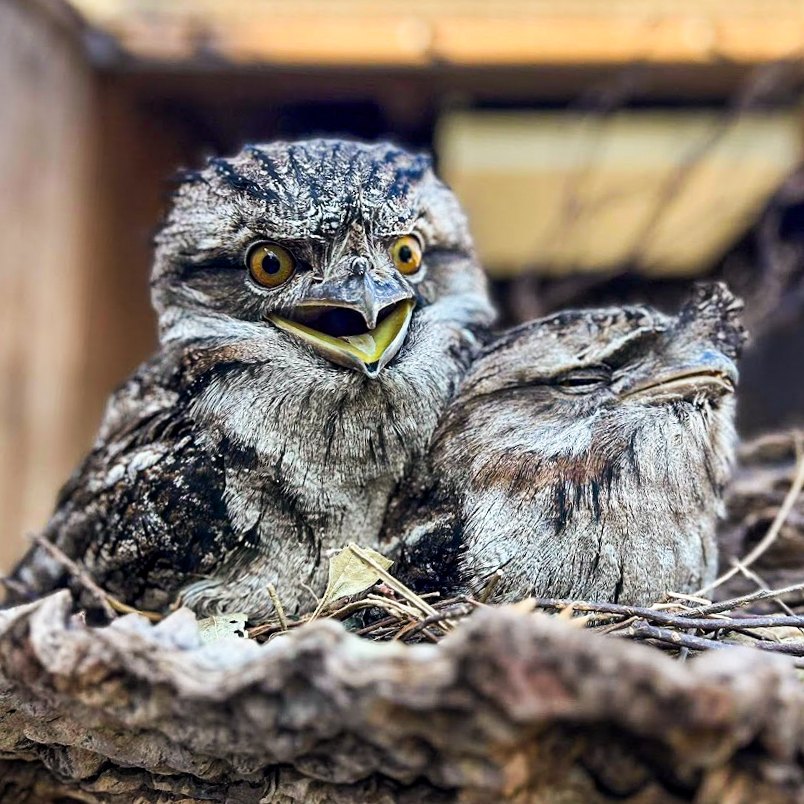- Characteristics of the tawny frogmouth’s social behaviors, focusing on extroversion and shyness.
- Zoological insights into the habitat and biology of the tawny frogmouth.
- The role of zoos in species conservation, education, and public engagement.
- Techniques and strategies for zoo management of bird habitats.
- Impact of human interaction on the behavior of captive and wild tawny frogmouths.
The tawny frogmouth, native to Australia, is a fascinating bird known for its owl-like appearance. Despite their resemblance to nocturnal predators, these birds belong to the nightjar family and have a unique social structure. In this article, two tawny frogmouths with distinct personalities are highlighted: one extrovert and the other shy. Observed by Keeper Meghan, these birds provide insights into the diverse behavioral patterns seen among individuals of the same species.
Characteristics of the tawny frogmouth’s social behaviors, focusing on extroversion and shyness
The tawny frogmouth is a solitary and secretive bird by nature. They exhibit unique behaviors where some individuals display extroverted tendencies while others are more reserved. The extroverted frogmouth might be more curious, engaging actively with their environment and caretakers. In contrast, the shy frogmouth is more likely to remain subdued, blending into their surroundings to avoid interaction.
This difference in behavior is a key area of study in avian biology. Behavioral traits such as these may be influenced by a variety of factors, including genetic predisposition, environmental conditions, and personal experiences. An extroverted frogmouth might be more adaptable to changes and human presence, while a shy one might require careful handling to avoid stress.
These individual behaviors are important for zoo management and conservation efforts because they affect how birds react to captive environments and human interaction. Recognizing and accommodating these differences allows more tailored care, promoting the well-being of the animals.
Zoological insights into the habitat and biology of the tawny frogmouth
The tawny frogmouth’s habitat stretches across a wide range of environments, from woodlands to urban areas. They are nocturnal hunters, primarily feeding on insects and small invertebrates. Their mottled plumage provides excellent camouflage, allowing them to remain undetected by predators.
In captivity, replicating the natural habitat of tawny frogmouths is crucial for their health and behavioral enrichment. Providing a structurally complex environment with opportunities for hiding, perching, and foraging can help reduce stress and encourage natural behaviors. Enrichment activities that mimic their hunting strategies and flight patterns are often used in zoos to stimulate these birds.
Adaptability is a notable characteristic of tawny frogmouths, as they can thrive in various climates. This adaptability is being studied for its implications in conservation, especially in the context of habitat changes due to urban expansion and climate change.
The role of zoos in species conservation, education, and public engagement
Zoos play a significant role in conserving species like the tawny frogmouth. They provide safe environments for individuals who may not survive in the wild, support breeding programs, and contribute to scientific research that furthers understanding of these birds.
Education is another critical function of zoos. By exhibiting tawny frogmouths along with educational materials, zoos inform the public about the importance of biodiversity and conservation. Interactive exhibits using extroverted individuals can engage visitors, creating memorable learning experiences.
Zoos also collaborate with international conservation organizations to develop breeding programs that can bolster wild populations. This involves genetic research to maintain genetic diversity and enhance population resilience.
Techniques and strategies for zoo management of bird habitats
Managing bird habitats within zoos requires a thorough understanding of species-specific needs and behaviors. For tawny frogmouths, simulating natural lighting and sound conditions is essential to their nocturnal nature.
Maintaining a balance between accessibility for visitors and minimizing stress for the birds is crucial. This involves strategic placement of nesting sites and perches to allow the birds privacy, while still enabling public viewing.
Regular health checks and behavioral assessments are necessary to monitor well-being. Keeper Meghan’s observations of the frogmouths’ personalities help tailor their care routines, ensuring that each bird’s needs are met according to their unique behavior.
Impact of human interaction on the behavior of captive and wild tawny frogmouths
Human interaction can have varying effects on tawny frogmouths, depending on their individual personalities. In captive settings, understanding these effects is vital to providing appropriate care. An extroverted bird might enjoy engagement, benefiting from training activities and keeper interactions. In contrast, a shy individual may require a more hands-off approach to prevent stress-related issues.
Studies on human impact help develop best practices for raising awareness about minimizing human disturbances in their natural habitats. Educating the public about respecting wildlife boundaries can reduce negative interactions in urban areas where tawny frogmouths are increasingly seen.
Conservation campaigns often use these insights to advocate for protective measures and urban planning that considers the habitats of native wildlife, ensuring a coexistence that benefits both people and animals.
Through an understanding of these topics, we gain a deeper appreciation for the tawny frogmouth’s role in biodiversity and the importance of conservation efforts. By observing individual behaviors and adapting care plans accordingly, zoos contribute to the survival and well-being of these fascinating birds, fostering a connection between humans and nature.
*****
Source Description
One tawny frogmouth is an extrovert, and one’s a little on the shy side. Bet you can’t guess which is which! 😜🪶😑
📸: Keeper Meghan
Alt-text: A shot of the tawny frogmouths from beside their nest in their Bird Up habitat. The left frogmouth greets Keeper Meghan with big eyes and an open beak while the right frogmouth hunkers down and ignores the camera altogether.


